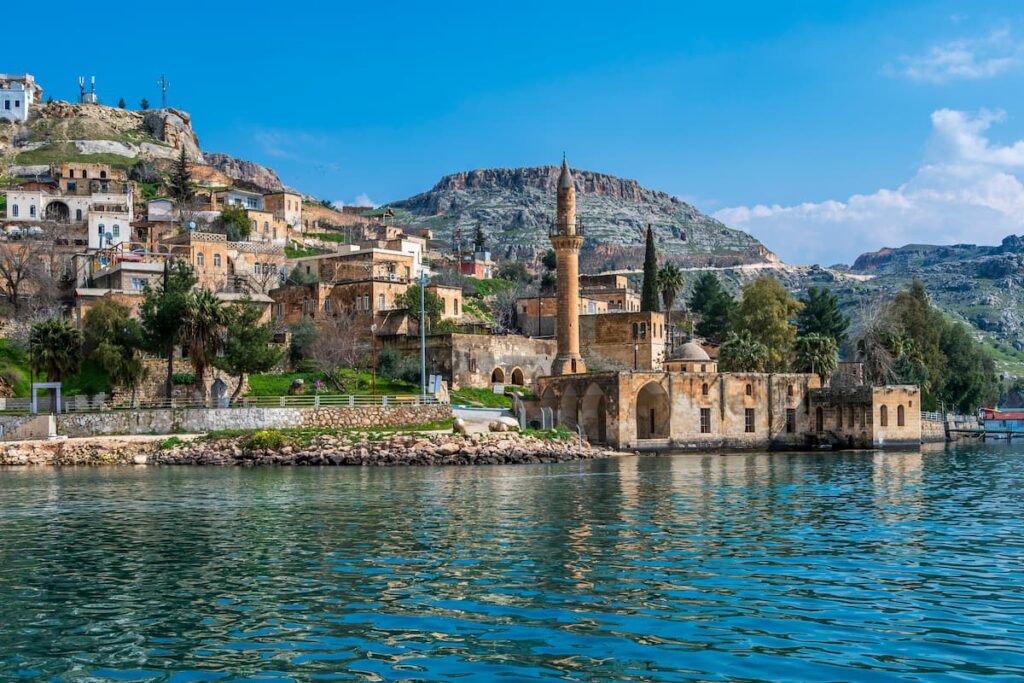A Historic Town Submerged by Progress and Reborn Through Tourism
In southeastern Turkey, on the banks of the Euphrates River, lies Halfeti — a town partly submerged by the creation of the Birecik Dam in 2000. Once home to over 2,600 residents, around 40% of the old town now rests underwater. Despite this dramatic transformation, Halfeti has reemerged as a unique destination that blends lost history with tourism, offering travelers the chance to explore ancient ruins, limestone caves, and the elusive “black” roses that bloom nearby.
The Birecik Dam project, part of Turkey’s larger regional development plan, forced the relocation of more than 6,000 people across Halfeti and neighboring villages. It now generates over 2,500 GWh of electricity annually and irrigates 70,000 hectares of farmland. While these economic benefits are undeniable, locals remain deeply aware of what was lost beneath the rising waters. Among the submerged structures is the 19th-century Central Mosque, which still stands partially visible at the reservoir’s edge.
“Many cemeteries and homes are now underwater,” says historian and guide Erhan Yildirim. “You cannot bring back the culture again; culture stays under the water.”
A Town Adapting to a Submerged Future
Halfeti’s transformation from an agricultural hub into a tourist attraction has been swift. Boat operator Muslum Karaman recalls how local livelihoods once centered on pistachio farming and animal husbandry. Today, that economy has shifted toward tourism, with many residents converting their homes into boutique cafés and floating restaurants. Visitors can enjoy regional dishes such as grilled freshwater carp while overlooking the submerged cityscape.
Tourists are drawn to Halfeti not only for its surreal beauty, but for the opportunity to explore the remnants of its past by boat, jet ski, or even flyboard. Diving excursions have gained popularity since Turkish freediver Şahika Ercümen performed a dive in Halfeti to raise awareness about water pollution. “You feel history,” says Yildirim, referring to the river’s ecosystem and nearby limestone cave networks.
Above water, Halfeti remains equally captivating thanks to a local botanical curiosity: the so-called “black” rose. Grown only in this region, these roses are not pure black, but rather a dark crimson that appears black in certain lighting. The color is believed to be the result of the area’s unique soil and climate conditions. Unlike most commercial roses grafted onto neutral rootstock, local growers use original roots suited to acidic conditions, which may intensify pigmentation.
Mystery and Legend Behind the Black Rose
The black rose of Halfeti has inspired local legend and international fascination. One story speaks of Adir, a mosque architect, and his granddaughter Vartuhi, who fell in love with an orphan named Firat. Forbidden from being together, the two leapt into the Euphrates and drowned. From that moment, roses in Halfeti turned black as a symbol of eternal sorrow.
Another tale says the Devil cursed the flower to bloom only where an innocent was murdered, making the black rose a permanent emblem of grief and revenge. Whether myth or truth, the roses have become part of Halfeti’s identity, inspiring products like teas, soaps, and perfumes. Even British brand Penhaligon’s released a fragrance named “Halfeti,” further boosting the flower’s cultural reach.
Horticulture experts agree the flowers are not truly black. Michael Marriott and Guy Barter, renowned specialists, confirm that the shade is a very deep red or maroon. But for locals and tourists alike, the distinction is symbolic rather than scientific. “Only very picky people would complain,” says Barter.
Layered History Beneath the Surface
Just a short boat ride from Halfeti is Rumkale Fortress, an imposing historical structure perched above the river. Its origins trace back to the Byzantine era, and it later served as the seat of the Armenian Church’s spiritual leader during the 12th and 13th centuries. Conquered by the Mamluks in 1292 and later absorbed by the Ottoman Empire, the fortress reflects the region’s complex past.
Visitors to Rumkale can walk among its surviving Armenian walls and glimpse how its strategic position once shaped religious and military power in the region. The journey from the submerged city to the ancient stronghold underscores the long arc of history that defines this part of Turkey.
In recognition of its cultural richness and commitment to preserving tradition, Halfeti joined the Cittaslow network in 2013 — an international program that celebrates small towns offering a high quality of life. Residents continue to cherish their history, even as they adapt to new economic realities.



